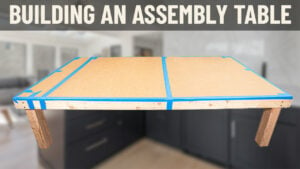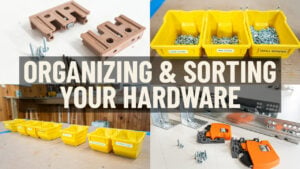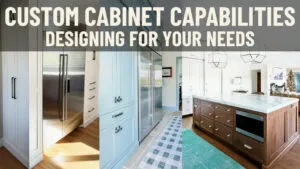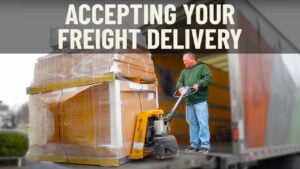Video Transcript
Hey everybody, Brian from The Cabinet Joint here. We’re going to be shooting today the video to end all videos on tools and supplies. We’ve shot this video a few times in the past, but through our experience with our shop here in Gettysburg, assembling these cabinets over and over again, we’ve tried to fine-tune the way we do things. We thought that you might benefit from that experience as well.
I’m going to go through pretty much everything. You don’t need everything in front of me to build all the cabinets. For some, it’s just going to be a rubber mallet, a bottle of glue, and a brad gun or a staple gun. For others, you’re going to need squares and clamps. So, I want to explain each of those instances as we go through.
I’m going to work from left to right and show you what we’ve got here. Some of these tools you’ll have kicking around your own house. All of them are available at Lowe’s, Home Depot, or any local hardware store. In the case of power tools and compressors, that might get a little more expensive to buy. You can typically rent them for a weekend or whatever if you don’t want to go buy it. So, let’s get started. Okay, first of all, we have two different versions of impact devices here. You don’t want to constantly use the palm of your hand to push your cabinet parts together; you’ll get real sore real quick. So, we do use a rubber mallet to tap the parts together. You’ll see that in all of our videos. We tend to like a dead blow—it’s just that you don’t have to swing it so hard. Not that you’re going to swing hard anyway, but it does a nice job of acting as the leverage versus your arm. Some people find they like the rubber mallet better because it’s a little more finessing. But if you’ve got a pretty good feel for hitting your parts together, this is a 26-ounce dead blow. This is our favorite. We do have the rubber mallet, and these are a lot cheaper if you want to buy that at Lowe’s or Home Depot. Either one will work.
The second thing you’re going to need is some way to hold the cabinets together. Again, the glue is only acting as your final fasting device. The brads or staples are really acting as the way to hold the cabinet together until that glue sets. We like a staple gun. Staples are traditional—I think they’re 5/16 wide and an inch and a quarter long. We like the staple because you get two points of contact. As long as you keep the staple oriented right—like not this way where it’s going to shank out inside your cabinet side interior—but this way, we like the staple a lot better. We’ve been using it for about five or six years now with a stapler, and we like it. If you want to use a brad gun, it shoots a one-point-of-contact 18-gauge brad, also an inch and a quarter. That works just as well. Some people feel they have better control with a brad because you’re not worrying about the orientation of the gun as you’re driving your staples. It’s fielder’s choice.
I have in front of me a bottle of glue. We use Titebond 2. Titebond 3 is another option you can use; it has a little longer open working time, so it doesn’t set up quite as fast. If you have to rework a part, you put a cabinet off to the side, and you’re like, ‘Oh, that frame is not quite tight to the box,’ it’ll stay as an open working time a little longer. I like the Titebond 2 because I want it to set up fairly quickly, so I don’t have glue running out the bottom of the frames. And this still will stay open for about 20 minutes or so. Again, fielder’s choice. We like Titebond 2; you may want Titebond 3—potato, potato—it doesn’t really matter. I have a little cup here. This is just to represent—you can use red Solo cups, Dixie Cups, or Tupperware—whatever you want. You’re going to need something to put screws and hardware in. If you’ve watched one of our welcome series videos on sorting your hardware, you’ll have a lot of screws as you open up your bags of hinges and glides. There are all sorts of little screws and pieces you want to keep straight. We like to sort them in any kind of container and then have those containers handy when we go to upfit the cabinets at the assembly stage. So, just have an assortment of cups; that’s fine.
I have a rasp file here or any kind of file. We do find that occasionally you’ve got machining on these pieces—these pieces of wood that you’re putting together for the cabinets—that have dovetails. Sometimes those are tight; you know, wood expands. So, you want to have a way to kind of free the dovetail up if you get a tight assembly or some fuzz in the dovetail. You can use the rasp file to run it through the dovetail and clean that out. A pencil for marking—you’re going to have to mark scribe lines—and any carpenter needs a pencil, so I have a few of those around. Tape measure, of course, to measure things. Um, a razor or a box cutter or something like that to cut strapping, cut cardboard. Um, cut the tape that holds the foam onto the finished pieces. You’re going to need some kind of a razor blade or a knife. Here, I’ve got a chisel, just a small one, maybe a 5/16 chisel or something along that line. This is to clean out, uh, again, if you have a dovetail that’s got a piece of debris in there or you want to pry a spline out to move it when you’re assembling a cabinet box. It’s just good to have a chisel and an assortment of chisels around.
Uh, a pair of pliers—we don’t have a lot of use for pliers, but they’re good to have around. Again, if you want to pull a spline out that has to be relocated or, um, a nail or a brad shank to the inside or outside of the cabinet, you’ll want to pry that out. You’ll see I sometimes use these in the assembly videos.
I’ve also got a little Phillips head screwdriver—short one’s good so you can work inside smaller cabinets. But a Phillips head screwdriver is going to be critical when you’re adjusting hinges and that kind of thing.
I’ve also got two versions of a screw gun. One is the impact driver we like. This is what we use to put our hinge screws on. You’ll see this used all the time in the videos—impact style. You’ll have an assortment of tips. Some are going to be like a Torx bit, and some are going to be Phillips. So, you’re going to want an assortment of tips or bits. And then I have my normal screw gun. This is going to be for all your pre-drilling activities—pre-drilling for your hinges, pre-drilling for your drawer glides, all those kinds of things. You’ll see us use drills quite a bit. And then, of course, with the drill, you’re going to want a box of assorted-sized drill bits. I typically stay within this range—you don’t get into these big ones very often—but you’re going to want to have those smaller ones around.
I’ve also got a self-centering bit. This is pretty critical; it’s not necessary, but we like it because it helps. Let’s just say I had a hinge going on a door—the tip on this is self-centering. It’s got a little taper at the bottom, and as you push it in, it’ll center the drill bit in the center of the hole. So, you don’t have to worry about being off-center, and then the piece moves when you go to screw it on. These are, I think, six or seven bucks at Lowe’s. They’re good to have around—again, not critical if you don’t have it, but you just have to be a little more careful: Am I in the exact center of the hole I’m trying to drill?
This box represents an assortment of screws you’re going to need. A lot of folks assume that when they order cabinets from Conestoga or from us, and they come from the vendor, that they’re going to have all the screws they need for installation and all that. But they don’t. They don’t send the screws with the cabinets that hold the drawer front to the drawer box. So, we use an inch-and-a-quarter screw represented here. You’ll see that in other videos where we’re upfitting. They also don’t come with the screws to hold the cabinets to the wall—like a 3-inch Fathead screw to hold the cabinets to the wall. The cabinets to each other—if you’ve got to go through front frames—the cabinets to each other—those screws are not included. So, you do have to go to Lowe’s or Home Depot or some local hardware store and pick up your screws for basic installation and assembly tasks. Which you’ll see in the videos, we’ve got some blue tape here. Painter’s tape is always good to protect finished surfaces from marring. If you’re going to have to cut something on a table saw or what have you, it’s good for protection.
I’ve got the infamous wet rag. I always keep this around for your assemblies. You’ll see it in every video because your final operation is going to be to wipe that glue out of the inside of the cabinet, so keep that handy.
I’ve got a square. We use this for marking quite a bit. If you’re doing a case-only cabinet, anywhere you want to strike a line, you want to make sure that’s square to the front frame or to the back of the box. So, you’ll see us use the framing square quite a bit. Along with that, we have a little square kicking around. We show this in the videos as a way to scribe the side of the cabinet. We use this for hardware installation—you’ll see us use it when we’re putting hinges on doors in those videos. So, a little framing square—great, not framing, but a little detail square.
Then we have a couple of clamps—big and small. If you’re doing a flush-finished end, you’re going to want to hold that cabinet frame tight to the box. So, we always want to have an assortment of clamps around. I’m showing one of each size here. I would say you’re probably going to want four or five bigger clamps. If you have a tall cabinet with one big flush side, you’re going to want to clamp that in various places. These aren’t cheap—if you go to Lowe’s or Home Depot, I want to say they’re probably 30 bucks each. If you’ve got a friend who can lend them to you, that’s great. But you’re going to want to have clamps around. And we are building cabinets here, and we do want to get things tight. So, in certain cases, as the videos show, you’re going to want to have some clamps around.
And I think that really covers it. If you have questions, your cabinet coaches are always available to counsel you through an assembly issue. We’ve got lots and lots of videos you can refer to where you’ll see all this stuff being used. But again, if you have any questions, call your cabinet coach. We want your cabinets to be built tight. We want you to have a good experience, and we want, at the end of the day, for you to walk into your kitchen and love it every time you walk in to get your coffee. It all starts with having the right tools and not trying to cobble it together when you don’t have the right tools. So, make the investment or borrow them. But this is really a representation of what you’re going to need to build a quality box. Thanks for watching!





What size clamps should I get? I don’t see you actually use a lot of clamps in the assembly videos. Are they primarily for installation? One of your links takes you to some 6″ and 12″ clamps but it looks like you have some larger clamps in this video.
Michael – we suggest getting clamps sized to the maximum width of your cabinets